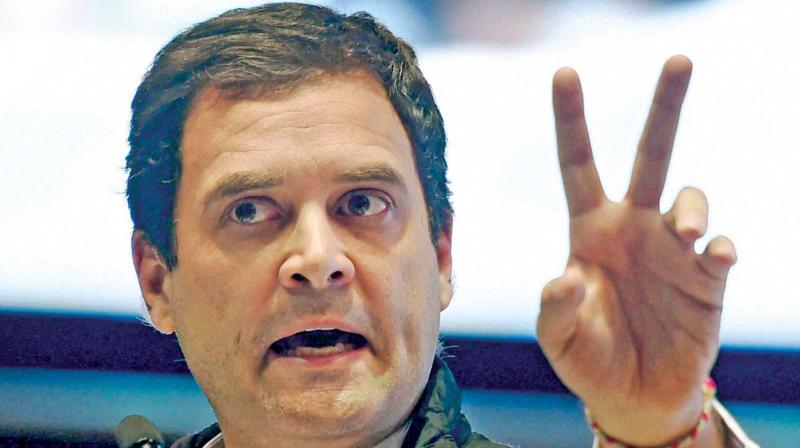Rahul 2.0: His challenge is to make people accept Congress

The biggest challenge before Rahul Gandhi, all set to take over as president of the Congress from his ailing mother Sonia Gandhi, is not whether he is accepted by the party but whether he can make the people accept the party as an alternative to the BJP, which is ruling at the Centre and in 18 of 26 States. It hardly matters whether he gets unanimously elected or coronated by the party, “like Aurangazeb” as Mani Shankar Aiyar put it, when the organisational election takes place later this month. The final test is whether he can win elections for the party. This is the toughest challenge as his election comes ahead of Gujarat and Himachal Pradesh elections. And Assembly elections are due in Karnataka.
Rahul has been Congress vice-president for five years, and this has coincided with some of the worst defeats that the party faced in Sate assembly elections as well as in the 2014 Lok Sabha polls. However, there have been frequent resurgences of the leader, and now, with a reinvigorated online and offline avatar, Rahul seems poised to take over. Dynasty is not new to Congress nor is it confined only to that party. The succession from Nehru to Indira to Rajiv Gandhi shows a smooth succession. But then Rajiv Gandhi was the last Prime Minister to come from the Nehru family. He came with a three-fourths majority in the Lok Sabha elections held in the immediate aftermath of his mother and Prime Minister Indira Gandhi's assassination in 1984. He frittered away all the goodwill in five years over Bofors and lost in 1989. But when the Congress came back to power in 1991, it was Narasimha Rao who was the Prime Minister and Sonia Gandhi, who was offered power on a platter, preferred to lead the party and legitimised her extra-constitutional role later by heading the governing council.
Dynasty or not, it was Sonia who led the Congress to power in 2004 by forming the United Progressive Alliance coalition and even got a second term till 2009. It was a different matter that UPA II's rule was marked by mega scams all because Manmohan Singh and Sonia Gandhi gave in to coalition compulsions - coalition dharma they called it - and allowed partners to freely indulge in corruption. Like Rajiv and Sonia, Rahul also showed reluctance to assume responsibility all these years. Now he is taking charge at a time when the party's fortunes are at low ebb. Modi with 31 per cent vote share, has led the BJP to a majority on its own, a record of sorts. But after three years, anti-incumbency is building up over growing intolerance, vigilantism and unilateral decisions on reforms like demonetisation and the GST which have hurt the common man and the small business.
This is the opportunity Rahul should seize upon. If his interaction with students at the University of California last September is any indication, he has shown maturity unlike a few years earlier when he showed his impetuosity by tearing up cabinet papers. But then Rajiv Gandhi was equally at times impetuous as when he announced at a press conference that the then Foreign Secretary would be replaced. If Rahul’s remarks at the Berkely event is any indication of his thinking, the Congress will have to be revamped, by bringing a right mix of youth and experience. As he put it: “I am absolutely ready to take up the executive role, but our party works according to organisational elections. I believe that young people should be pushed forward. But there’s also tremendous talent in the party among the senior people. It's a mix, it’s trying to make both systems work together".
Rahul cannot match Modi's dynamism and oratory. More than that, Modi has a well-oiled machinery in the RSS. This is where the Congress is enfeebled. No point in blaming Rahul for this. The decline started with Indira Gandhi who split the party in 1969 in a naked power struggle and threw out the old guard and regional satraps. Insecure unlike Nehru, she surrounded herself with sycophants like D K Baroah who came up with the infamous slogan, “Indira is India”. Rajiv had contempt for sycophants and when he showed this to Anjaiah, he ended up with the charge of hurting Telugu pride and the consequence was the Telugu Desam Party. Rajiv was also accused of surrounding himself with trusted lieutenants like Arun Nehru and Sam Pitroda.
Rahul, on the other hand, says the Congress lost because power went to its head. As he put it: “In 2012, certain arrogance crept into the party and we stopped having a conversation. For rebuilding the party, we need to design a vision that we can use moving forward. Most of what the BJP is doing right now, like MNREGA and GST is what we once said”. In the ultimate analysis, Rahul leadership will be decided by his 'winnability'. The road to 2019 will be rough. The BJP is in power in 18 out of 26 States which account for 70 per cent of the people. Against this, Congress was in power in 17 States in 2006. The way forward is consolidation of secular votes through a coalition based on shared ideology and not on blind anti-BJPism, which will not work as the Janata experience based on anti-Congressism has shown.
Already at the national level, there are two groupings, the NDA and the UPA. Rahul’s job should be to expand the UPA to take on the BJP. And like it or not, Congress or Congress-led coalition is the only secular alternative to the BJP and its allies, which believe in ultra nationalism or Hindutva. That is the opportunity Rahul should work on.

